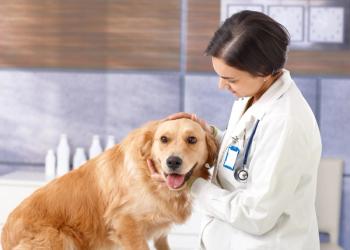
Early detection of cancer requires persistent checks
The eyes are often a site of primary or metastatic neoplasia.
Cancer is the leading cause of natural death in dogs and cats. Recent advances in diagnostics and treatment allow for prolonged survival times and improved quality of life in pets with cancer; however, many cancers are not detected until they are advanced, limiting treatment options to palliative care only. In human medicine, tests for early detection of cancers including skin, prostate, cervical, colorectal and breast cancer are increasingly being promoted by physicians and other health advocates to improve patient care and survival. Due to ever-increasing awareness about cancer, pet owners are seeking information about prevention, early detection, diagnosis and treatment of cancers.
Early detection of cancer
Early detection of cancer in pets requires a conscious effort by the owner and the veterinary healthcare team. From the first time a patient is seen by a veterinarian, the importance of preventative care, including regularly scheduled examinations, should be emphasized. Owners should be encouraged to examine their pets for new or changing problems, and to seek veterinary attention when abnormalities are detected. The best method for early detection of cancer and other conditions in veterinary patients is a semi-annual (or more often in some cases) physical examination by a veterinarian. The history and physical examination should be used to determine if further testing (i.e., bloodwork and imaging) is indicated.
Exploring The Vet Cancer Registry
Physical examination
During a routine physical exam, the following organ systems should be carefully examined, especially in older pets or in patients suspected or known to have cancer:
- Eyes: The periocular and intraocular (including funduscopic examination) structures should be routinely examined. Due to their rich blood supply and extension to the central nervous system, the eyes are often a site of primary or metastatic neoplasia. Decreased ocular retropulsion can indicate nasal or orbital tumors; hyphema may be a sign of intraocular neoplasia (most commonly lymphoma or primary intraocular tumors); raised masses on the iris may be iris melanomas.
- Ears: Examination of the external ear canals should be performed in every patient. Animals with a history of prolonged or recurrent otitis externa may be at increased risk for development of ear canal tumors. The clinician should maintain a degree of suspicion for neoplasia in older pets with a recent onset of otitis externa or purulent or hemorrhagic aural discharge. Debriding of aural secretions with subsequent otoscopic examination under general anesthesia is required to visualize most ear canal tumors. Because tumors in the ear canal are often infected and inflamed, exercise care to ensure that representative samples of the tumor are obtained.
- Nose: Clinical signs associated with nasal tumors include mucopurulent or hemorrhagic nasal discharge, rubbing or pawing at the face, sneezing, and uncommonly, neurologic abnormalities, such as seizures or behavior changes or ocular abnormalities such as exophthalmos. It is important to assess patients with suspected nasal tumors for facial deformity, masses protruding through the palate, airflow through the nostrils, and an ability to retropulse the eyes.
- Throat: Careful palpation of lymph nodes (including mandibular and superficial cervical) and the thyroid area are essential. Because most thyroid tumors in dogs do not secrete thyroid hormone, they often grow undetected until they cause compression of surrounding normal tissues, resulting in clinical signs such as dyspnea and dysphagia. Early detection of thyroid tumors would maximize available treatment options and decrease morbidity associated with this tumor.
- Peripheral lymph nodes: The regions of the mandibular, superficial cervical (prescapular), axillary, inguinal and popliteal lymph nodes should be routinely palpated. In dogs, axillary lymph nodes are not normally palpable. In most cats, superficial cervical, axillary and inguinal lymph nodes are not routinely palpable. Aspirates are indicated to evaluate lymph nodes that are enlarged or irregular.
- Thoracic cavity: Thoracic auscultation should be performed in every patient. Muffled heart or lung sounds and/or increased respiratory effort may result from primary or metastatic lung tumors, pleural effusion or heart-based tumors.
- Abdominal cavity: Careful palpation of the spleen, liver, kidneys and gastrointestinal tract may reveal organ enlargement or masses.
Genitourinary system: Careful palpation of the mammary glands should be performed in male and female dogs and cats. In females, the perivulvar area should be visually examined for masses. In females with a history of vaginal discharge, digital rectal and vaginal examinations are indicated. The testicles should be examined for masses and asymmetry in intact male dogs. In intact and neutered male dogs, digital rectal examination of the prostate should be performed to evaluate for asymmetry and pain.
Nervous system: A complete neurologic examination should be performed on patients with sudden onset of seizures, vestibular abnormalities or behavior changes, since these signs may indicate primary or metastatic intracranial neoplasia.
Musculoskeletal system: A thorough examination of the appendicular and axial skeleton, including the digits, is indicated in all patients. Pets that develop a sudden onset of lameness should be assessed radiographically to evaluate for primary bone tumors. In dogs and cats with a known history of osteoarthritis, worsening of lameness or becoming refractory to medical management may be a sign of underlying neoplasia.
Rectal examination: This is an essential part of the physical examination that will allow for evaluation of the rectum and anal glands, genitourinary system and medial iliac (sublumbar) lymph nodes.
Skin and subcutaneous tissues: Skin and subcutaneous masses should be measured with a caliper and aspirated to obtain a diagnosis. Size measurements and results of aspirates should be recorded on a body map and should be re-examined at least every six months, or more often if the masses are enlarging or changing in texture. Masses confirmed to be neoplastic via cytology should be removed.
Hematologic and imaging examinations
In older pets, annual (or more often if indicated) bloodwork, (CBC, serum chemistry profile, urinalysis, thyroid levels in cats) is an invaluable screening tool for detection of common problems, including neoplasia. CBC abnormalities that might indicate underlying neoplasia include regenerative or non-regenerative anemia, thrombocytopenia, neutrophilia and abnormal cells in circulation. On the serum chemistry panel, abnormalities indicating organ dysfunction are not specific for neoplasia, but they can identify which organ systems need to be further evaluated.
Paraneoplastic syndromes including hypercalcemia, hyperglobulinemia and hypoglycemia are identified with a chemistry panel. Occasionally on a urinalysis, neoplastic transitional cells may be identified in the sediment. Generally, abnormal laboratory values are non-specific for a certain tumor type but aid the clinician in determining what imaging or other tests are required to further assess the patient.
For example, the presence of abnormal cells in circulation suggest that a bone marrow aspirate and/or core bone marrow biopsy are indicated, and increased liver enzymes indicate the need for additional liver function testing and/or ultrasonographic evaluation of the liver.
In some cases, clients may wish to pursue additional testing to screen their pets for cancer. Thoracic and abdominal radiography and abdominal ultrasound are useful in identifying tumors, often much earlier than they could be detected via physical examination. Detection of intracavitary tumors prior to the onset of clinical signs may increase treatment options and improve patient outcome. For most animals, annual imaging tests should be sufficient for early detection of neoplasia; however, in pets with a history of cancer, more frequent testing may be indicated. Advanced imaging techniques such as CT, MRI and PET scans may be indicated in some cases, but currently are not routinely used in companion animals as screening tests for cancer.
In human medicine, "blood tests for cancer" are increasingly commonplace. The prostate-specific antigen (PSA) is a well-accepted screening blood test for prostate cancer and is recommended annually for men beginning at age 50. Mammograms, PAP smears and colonoscopies are additional but more invasive means for the early detection of cancer in people. In dogs, the following tests have been used in the early detection of cancer:
- The BTA (bladder tumor antigen) test, performed on urine, is a screening test for transitional cell carcinoma (TCC). Although this test is sensitive, it is not specific for TCC in dogs with other causes of urinary tract disease (pyuria, etc.); therefore, it should be used as a screening test to rule out TCC in dogs with lower urinary tract signs. In dogs with positive BTA tests, confirmatory testing including contrast radiography, ultrasonography and cystoscopy should be pursued.
- A test that can aid in the diagnosis of lymphoma is the PCR (polymerase chain reaction) for Anitgen Receptor Rearrangement (PARR). This test uses PCR technology to determine the clonality (B or T phenotypes) of lymphocytes in lymph nodes, peripheral blood, bone marrow, non-formalin fixed samples of lymph nodes and other tissues, and other body fluids. The presence of an identical population of lymphocytes in tissues or blood strongly suggests a diagnosis of lymphoma. This test is useful in cases where the diagnosis of lymphoma is ambiguous or difficult. Examples include: lymph-node biopsies consistent with lymphoid hyperplasia; peripheral lymphocytosis; or in patients with hypercalcemia, where lymph node aspirates and bone marrow may be used to identify a clonal population and diagnose lymphoma.
Researchers are currently working on a blood test for canine hemangiosarcoma. Flow cytometry is used to detect endothelial precursor cells, which are present in circulation in dogs with hemangiosarcoma but not in normal dogs. Preliminary data are promising for using this test to confirm a diagnosis of hemangiosarcoma in animals suspected of having this disease. The researcher's goal is to use this test to identify hemangiosarcoma in dogs prior to the onset of clinically detectable disease.
Prevention of cancer
Strategies for cancer prevention, when available, may be of interest to clients and veterinary professionals. Cancers with proven or suspected links to hormonal or environmental causes may be preventable. Obviously, owners would have to be counseled early in the pet's life to try to prevent a certain type of cancer. The most documented example of this is ovariohysterectomy (OVH) in dogs. It is known that OVH prior to the first heat cycle dramatically lowers a dog's lifetime risk of development of mammary cancer. This is also likely true in cats. In male dogs, castration eliminates the possibility of testicular cancer.
Sun-induced cancers in dogs and cats may be prevented by limiting sun exposure. In dogs, sun-induced tumors include hemangioma, hemangiosarcoma and squamous cell carcinoma. These cancers are most commonly seen in dogs with light haircoats who have a history of sunbathing. Most often, sun-induced skin lesions are seen on the ventral thorax and abdomen, and are often first noticed in their early stages, appearing as scaling, erythematous skin with comedones. These lesions are generally diffuse in nature rather than localized due to a "field cancerization" effect of sun exposure to the entire ventral skin surface, and are often difficult to treat. In cats, squamous cell carcinoma is the most common sun-induced tumor, and affects light-colored skin on the tips of the ears, nose and periocular regions. Owners presenting young animals to the veterinarian for routine examinations should be counseled about limiting sun exposure in pets at risk, especially in households located in high altitudes and the southern United States.
In cats, the development of sarcomas is well-documented following vaccination and other injections. Practitioners are advised to limit vaccines in cats to those that are necessary for a particular patient. Also, exposure of cats to tobacco smoke has been linked to development of lymphoma and oral squamous cell carcinoma. These cancers are seen more often in cats with exposure to environmental tobacco smoke and increase with duration of exposure to smoke and number of cigarettes smoked daily in the household.
It's a team effort
Early detection and prevention of cancer should be the result of a team effort between veterinary staff and pet owners. Veterinarians should educate themselves on new and emerging technologies in this area, and pet owners should be encouraged to be diligent about observing their pet for new problems and seeking veterinary attention when necessary.
Dr. Gieger is a 1996 graduate of Louisiana State University School of Veterinary Medicine. She completed an internship at the Animal Medical Center in New York, a small animal internal medicine residency at Louisiana State University and a medical oncology residency at the University of California-Davis. She is a diplomate of the American College of Veterinary Internal Medicine in the specialties of small animal internal medicine and oncology. Dr. Gieger is a radiation oncology resident at Cornell University. She was an assistant professor of oncology and internal medicine at the University of Georgia. Her clinical research interests include mast-cell tumors and nasal tumors.
Dr. Northrup, dipl. ACVIM, is an assistant professor of oncology at the University of Georgia.
Newsletter
From exam room tips to practice management insights, get trusted veterinary news delivered straight to your inbox—subscribe to dvm360.






